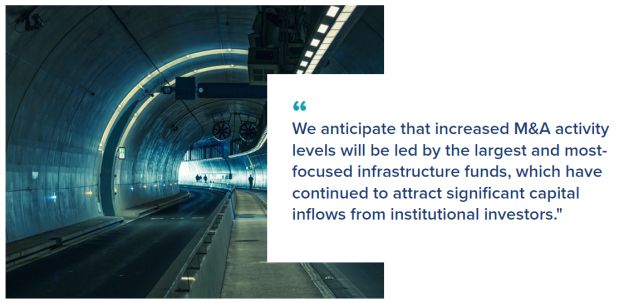Although fundraising in infrastructure was more subdued in 2023, M&A continued to play a crucial role in recycling and putting capital to work across the sector. However, the macro-economic headwinds which led to inflation and higher borrowing costs caused price dislocation between buyers and sellers of infrastructure assets, resulting in lower volumes of transactional activity than in recent years.
The outlook for infrastructure M&A in 2024 appears far more positive. We and our clients expect more infrastructure deals to get airborne in 2024, driven by a number of factors, including less volatility in debt markets, a narrowing of bid-ask spreads and pressure on fund managers to deploy or return their 'dry powder'.
Vast capital requirements
The volume of capital required in both developed and emerging markets to develop and renew infrastructure assets is vast. The UN-backed Global Infrastructure Hub projects that the combination of population growth, digitalisation and the quest for net zero will leave a gap between government spending and the amount needed of some US$500 billion in 2024 alone, reaching US$15-18 trillion by 2040. Faced with such shortfalls, governments will continue to develop ever-more innovative models to attract private capital and ever-earlier in the development process.
We anticipate that increased M&A activity levels will be led by the largest and most-focused infrastructure funds, which have continued to attract significant capital inflows from institutional investors. In parallel, commitments continue to flow into smaller, specialist funds, focused on strategies such as digital transformation and the energy transition.

Securing best value for investors remains paramount, with funds and managers focused on balancing risk and returns. We expect investors to place renewed emphasis on deal structuring and downside protections. In addition, after a period of relatively subdued activity, we anticipate that investors who have resisted bringing assets to market in recent years will be looking for liquidity opportunities. For these players, thoughtfully designed and well-prepared sale processes will be crucial to maximising value and achieving a clean exit.
Another feature of the transactional landscape which seems set to remain is the continued prominence of platforms. Strong management teams with proven track records of developing infrastructure assets will only be in greater demand in the coming year as investors seek out exposure to the novel technologies underpinning the new economy.
Key areas of opportunity
- The two dominant themes shaping infrastructure investing are decarbonisation and digital transformation, with both driving exceptional levels of M&A activity around the world as corporates and investors compete for the assets delivering decarbonisation. We examine the impact of the push for decarbonisation further in our M&A insights article focusing on the energy transition.
- Policy incentives will continue to influence where around the world investors choose to deploy capital, while at the same time governments will continue to expand their policy toolkits aimed at guarding against unfair competition and foreign influence.
- In recent years, the "dash for digital" has seen phenomenal volumes of capital deployed across mobile towers, fibre, satellites and data centres.
- With the advent of AI and the Internet of Things, an exponential expansion in demand for data storage and faster connectivity is leading to even greater focus from investors on the asset class. We see this trend continuing for the foreseeable future and intersecting with the energy transition as operators look for sustainable sources of energy to power the digital transformation.
Across these themes, as investors encounter ever more innovative and unfamiliar technologies, the need for expertise of the revenue models and risk factors relevant to specific asset types will only increase.
Conclusion
Infrastructure seems likely only to grow in appeal to investors in the year ahead – offering as it does exposure to long-term, inflation-protected predictable returns with significant downside protections. While in a turbulent world shocks cannot be ruled out, infrastructure offers resilient opportunities for long-term investors to support the capital expenditure needed for systemic change.
To view the full article, click here.
The content of this article is intended to provide a general guide to the subject matter. Specialist advice should be sought about your specific circumstances.



